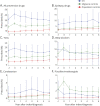Headache, Opiate Use, and Prescribing Trends in Women With Idiopathic Intracranial Hypertension: A Population-Based Matched Cohort Study
- PMID: 35985824
- PMCID: PMC9651462
- DOI: 10.1212/WNL.0000000000201064
Headache, Opiate Use, and Prescribing Trends in Women With Idiopathic Intracranial Hypertension: A Population-Based Matched Cohort Study
Abstract
Background and objectives: Physician prescribing habits for opiates and headache therapies have not been previously evaluated in a large, matched cohort study in idiopathic intracranial hypertension (IIH). Our objective was to evaluate opiate and headache medication prescribing habits in women with IIH compared with matched women with migraine and population controls. We also investigated the occurrence of new onset headache in IIH compared with population controls.
Methods: We performed a population-based matched, retrospective cohort study to explore headache outcomes. Cross-sectional analyses were used to describe medication prescribing patterns. We used data from IQVIA Medical Research Data, an anonymized, nationally representative primary care electronic medical record database in the United Kingdom, from January 1, 1995, to September 25, 2019. Women aged 16 years and older were eligible for inclusion. Women with IIH (exposure) were matched by age and body mass index with up to 10 control women without IIH but with migraine (migraine controls), and without IIH or migraine (population controls).
Results: A total of 3,411 women with IIH, 13,966 migraine controls, and 33,495 population controls were included. The adjusted hazard ratio for new onset headache in IIH compared with population controls was 3.09 (95% CI 2.78-3.43). In the first year after diagnosis, 58% of women with IIH were prescribed acetazolamide and 20% topiramate. In total, 20% of women with IIH were prescribed opiates within the first year of their diagnosis, reducing to 17% after 6 years, compared with 8% and 11% among those with migraine, respectively. Twice as many women with IIH were prescribed opiates compared with migraine controls, and 3 times as many women with IIH were prescribed opiates compared with population controls. Women with IIH were also prescribed more headache preventative medications compared with migraine controls.
Discussion: Women with IIH were more likely to be prescribed opiate and simple analgesics compared with both migraine and population controls. Women with IIH trialed more preventative medications over their disease course suggesting that headaches in IIH may be more refractory to treatment.
Copyright © 2022 The Author(s). Published by Wolters Kluwer Health, Inc. on behalf of the American Academy of Neurology.
Figures



References
-
- Daniels AB, Liu GT, Volpe NJ, et al. . Profiles of obesity, weight gain, and quality of life in idiopathic intracranial hypertension (pseudotumor cerebri). Am J Ophthalmol. 2007;143(4):635-641. - PubMed
MeSH terms
Substances
Grants and funding
LinkOut - more resources
Full Text Sources
Medical
